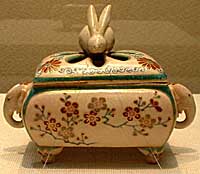|
JAPAN TIMES
Click here for
index to all
Yellin stories for
The Japan Times
USEFUL GUIDES

Timeline Guide
Books Guide
Glazes Guide
Keshiki Guide
Kiln Guide
Sake Shapes
Sake Vessels
Styles Guide
Technique Guide
Videos Guide
|
|
|
JUST DANDY
A Gathering of Kyoto's Ancient Masters
By ROBERT YELLIN
for the Japan Times, April 30, 2003
|
|

(ABOVE)
A small jar with maple leaf
by Ogata Kenzan
(BELOW)
Rabbit koro
by Nonomura Ninsei

|
|
|
|
|
|
|
Before the advent of 20th-century brand-name designers such as Kenzo, Miyake or Mori, there was Kenzan of Kyoto -- back in the Edo Period that is. His instantly recognizable signature was not found on any trendy kimono or handbag of the day, however, but on clay vessels.
Ogata Kenzan (1663-1743), his predecessor Nonomura Ninsei and his successor Aoki Mokubei (1767-1833) are known as "The Three Great Masters" of Kyo-yaki (Kyoto pottery). Kyoto is also famous for its Raku earthenware tea wares that date back 15 generations to their first creator, the legendary Chojiro (?-1589). Together, Raku and Kyo-yaki tea wares are cornerstones of Japan's ceramic heritage. More can be found on Kenzan, Ninsei, Raku, and Kyo-yaki by clicking here.
It's not often that a single exhibition offers a detailed look at the beauty of both Kyo-yaki and Raku-yaki, but the Idemitsu Museum in Tokyo is currently offering a glimpse into the fashionable Kyoto ceramic world of centuries ago in "Kyoto Kiln Ceramics for Tea Ceremony -- Ninsei and Kenzan from the Idemitsu Collection."
The beauty of this exhibition is in the dichotomy of the elaborately designed and executed Kyo-yaki pieces and the dark, subtle and somehow spiritual Raku chawan (tea bowls), particularly those made by Chojiro. We see here two aesthetics of not only Japanese pottery, but also of Japanese culture as a whole: the ornate and the sublime.
In my Feb. 12 column (30+ photos), I wrote about Rosanjin Kitaoji (1883-1959), the great artist who was a prominent admirer of Chojiro. Once he wrote, "The value of Chojiro's work lies in its refinement -- an essential ingredient of all art -- his warmth, his compelling dignity; all of which he shares in common with masters of painting, sculpture, architecture or any art."
A Chojiro chawan is so much in tune with the silent Zen world that the viewer should "see" the work in that context even though it actually sits in the glass case of a museum. Imagine sitting on tatami mats in a dimly lit room, the waft of incense in the air. In the alcove hangs an exquisite scroll that points the mind away from mundane worldly thoughts and toward the divine. Jade-colored matcha tea is served in a black chawan. It is a magical and transcendent experience.
However, that is not the case for the colorful jars, plates, chawan and incense utensils of the Kyo-yaki world. What these pieces exhibit is some of the finest brushwork done on ceramic vessels anywhere, ever. According to Masahiko Sato (in his book "Kyoto Ceramics"), the two basic features of Kyo-yaki are "the technique of covering one area of a piece solidly and thickly with a monochrome glaze, most often green or deep blue," and "the low-relief effect of many overglaze designs."
The designs and forms of almost all of the Idemitsu works -- whether they are Ninsei's elegantly refined pieces or Kenzan's boldly brush-stroked plates -- have a sense of balance and grace that earned them the label date-doku ("dandy" or showy utensils). Among the works showing here, Ninsei's large covered jar with a phoenix design in overglaze enamels and his large tea jar decorated with poppies (both designated important cultural properties) are cases in point. Using the rounded forms as a canvas, Ninsei created stunning new overglaze techniques on stoneware surfaces.
Kenzan, on the other hand, was more of an artistic director. Though he ran a workshop, even today we're not totally sure how much work he actually did. Labor was divided back then; you had a thrower, glazer, painter, kiln-firing team, etc. So when looking at Kenzan's work, you'll be seeing his vision -- but realized through teamwork.
When looking at Kenzan's masterpieces in the Idemitsu collection, we appreciate how the designer "pack[ed] so much into a single vessel," as Kenzan scholar Richard Wilson has written. (For more about Professor Wilson and his connection to Kenzan, see my Dec. 11 column.) What he is referring to are the eclectic motifs we find in Kenzan's vessels. There are elements of both Chinese and Japanese calligraphy, of painting, textiles -- and even hints of Dutch Delft-ware designs on some pieces.
Kenzan had to create a special plate called a kakuzara in order to fit all those elements onto one piece. Many depict seasonal scenes in a Japanese style that draw on the illustrated poems of Fujiwara Teika (1162-1241). Other kakuzara with illustrated poems are in monotone iron tones recalling Chinese landscape scrolls of the Southern Song Dynasty. Either with native or imported inspirations, kakuzara were created to serve up delicious morsels of formal kaiseki cuisine, or to serve sweets.
The Idemitsu Museum has one of the finest collection of Kyo-yaki in the world -- if not the finest -- and though this is the first time it has displayed so many of its masterpieces, it has been well worth the wait.
"Kyoto Kiln Ceramics for Tea Ceremony" runs till June 29 (2003) at the Idemitsu Museum, 9F Teigeki Bldg., 3-1-1 Marunouchi (next to the Teikoku Theater, near the Imperial Hotel), a short walk from JR Yurakucho Station or Hibiya Station on the Hibiya, Chiyoda and Mita subway lines. Open 10 a.m.-5 p.m. Closed Monday. Admission 800 yen.
The Japan Times: April 30, 2003
(C) All rights reserved
LEARN MORE
.
|
|